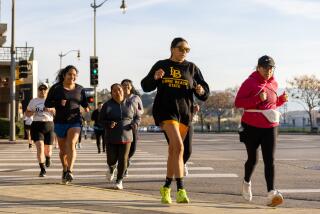Running for Those Who Can’t
- Share via
If your idea of running is getting to the video store one minute before closing or getting to the telephone before the answering machine picks up your call, how would you feel about running 26 miles? Yes, in one day.
Yes, you can do it.
And you can run a marathon to help someone who cannot.
“I thought, someday, it would be really neat to run one,” said Jaimie Gebler Matlock, 34, of Costa Mesa. “I also thought that was the kind of someday you put off forever.”
That “someday” dawns June 21, when Matlock participates in the first Rock ‘N Roll Marathon in San Diego. In what race organizers call “the biggest single-day charity payout in sports history,” Matlock and 6,000 other runners--one-third of the total field--are expected to raise about $13.5 million for the Leukemia Society of America.
“I used to think three miles was really long and really hard,” she said.
With a little guidance, 26 miles is . . . well, really long and really hard. But, for beginners and seasoned runners alike, the Team in Training program provides free clinics and training sessions with experienced coaches and covers transportation, lodging and entry fees for the race.
In exchange, runners raise funds for the Leukemia Society, which channels money into research, patient care and education about blood cancers that kill nearly 50,000 Americans each year. No disease kills more children, according to the Leukemia Society.
“You’re making a great effort to complete this race,” said Dwight Murray, 34, of Westminster. “Why not take advantage of it and do something for somebody else in the process?”
Matlock runs for her sister Suzanne, diagnosed with leukemia two years ago. Matlock donated the bone marrow that drove Suzanne’s leukemia into remission, but the marathon affords her--and another sister, Melisa--the chance to help patients everywhere.
Beneath her amusement, Suzanne is appreciative.
“She thought we were really nuts at first,” Matlock said. “She went through hell, she thought, so why should we go through hell, too? Now she feels honored.”
Murray runs for the City of Hope, the medical research and treatment center where he beat lymphoma, a cancer closely related to leukemia. Murray also runs for Matthew Jackson, 8, in remission from the same disease that threatened Murray’s life.
The Leukemia Society matches each Team in Training member with a leukemia patient--often, they meet--so runners can raise money on behalf of a specific person, not just for a faceless if noble goal. When training gets tough, when legs quake and cramps erupt, runners can draw inspiration from patients enduring chemotherapy or blood transfusions.
Marine Cpl. Philip Boelen, 21, stationed at El Toro, ran last fall’s Marine Corps Marathon in Washington, D.C. for a 5-year-old boy.
“He’s been through a heck of a lot more than I ever have,” Boelen said.
The Team in Training program does not rely solely on altruism and fitness to attract participants. What better lure than rewarding runners for training and fund-raising efforts with free entry to a marathon in glamorous locales such as Hawaii, Mexico, Canada, even Europe?
The Leukemia Society treats runners to a pasta dinner the night before each race. When nearly 3,000 runners descended on Alaska last summer for the Midnight Sun Marathon, team members filled both levels of the city’s convention center for what officials called “the largest sit-down dinner in Anchorage history.”
Since the Leukemia Society limits expenses to 25% of funds raised, runners must collect over $3,000 to travel to most foreign marathons. The local chapter of the Leukemia Society asked San Diego runners to raise $1,600.
*
Here, too, the Team in Training program offers assistance, sharing fund-raising tips.
Team in Training welcomes novice runners--and, in fact, depends upon them. The Leukemia Society trumpets its Team as “the largest marathon training program in the world.”
With national publicity and corporate sponsorship, the program exploded from 650 participants raising $1.3 million in 1993 to 14,000 participants raising $26.7 million in 1997. The local chapter of the Leukemia Society hopes to raise $750,000 this year, campaign manager Pam de Mahy said.
“It is cool to finish a marathon,” Murray said. “It’s even cooler to do something for somebody that couldn’t.”
(BEGIN TEXT OF INFOBOX / INFOGRAPHIC)
Teams in Training
The local chapter of the Leukemia Society is organizing Team in Training programs for the Canadian International Marathon in Toronto (Oct. 18) and the Cozumel Marathon in Cozumel, Mexico (Nov. 15).
For more information, call (714) 633-6858 or (888) 535-9300.
More to Read
Sign up for The Wild
We’ll help you find the best places to hike, bike and run, as well as the perfect silent spots for meditation and yoga.
You may occasionally receive promotional content from the Los Angeles Times.







